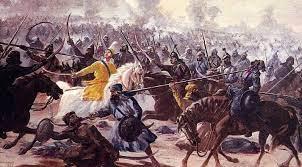The Hill Rajas and Mughals attack:
In 1704, the forces of the local Rajput Rajas who were alarmed by the rapid changes that Guru Gobind Singh was making in the rigid caste based Hindu religion. Particularly troubled over the growing number of converts from the Hindu and Muslim faiths and angered by the Guru putting a sudden and abrupt end to the converts' historical caste designations (even adopting the Rajputs' traditional name Singh (lion), previously only used by the Rajput warrior caste of Hinduism, sought the help of their Mughal allies to put and end to this new religion which clearly threatened their privileges.
The Mughals having lost men in previous battles with the Sikhs were only too glad to attack the fort of Anandpur, and after many months and several defeated attempts to take the city and a long siege, the Sikhs, low on both supplies and ammunition and nearly starved, agreed to abandon the city under a second promise of safe conduct to Punjab (during the first promise of safety a party of Sikhs and a 'pretend' treasure filled train of wagons was quickly attacked and looted), but to the dismay of the attackers the clever Guru had ordered the wagons loaded with trash covered in rich cloth. Under a second set of oaths 'sworn on the Qur'an and holy cow' (even bearing the mark of Aurangzeb) the Guru was finally persuaded by his devotees to give up Anandpur.
In 1704, the forces of the local Rajput Rajas who were alarmed by the rapid changes that Guru Gobind Singh was making in the rigid caste based Hindu religion. Particularly troubled over the growing number of converts from the Hindu and Muslim faiths and angered by the Guru putting a sudden and abrupt end to the converts' historical caste designations (even adopting the Rajputs' traditional name Singh (lion), previously only used by the Rajput warrior caste of Hinduism, sought the help of their Mughal allies to put and end to this new religion which clearly threatened their privileges.
The Mughals having lost men in previous battles with the Sikhs were only too glad to attack the fort of Anandpur, and after many months and several defeated attempts to take the city and a long siege, the Sikhs, low on both supplies and ammunition and nearly starved, agreed to abandon the city under a second promise of safe conduct to Punjab (during the first promise of safety a party of Sikhs and a 'pretend' treasure filled train of wagons was quickly attacked and looted), but to the dismay of the attackers the clever Guru had ordered the wagons loaded with trash covered in rich cloth. Under a second set of oaths 'sworn on the Qur'an and holy cow' (even bearing the mark of Aurangzeb) the Guru was finally persuaded by his devotees to give up Anandpur.
The Hill Rajas and Mughals attack:
In 1704, the forces of the local Rajput Rajas who were alarmed by the rapid changes that Guru Gobind Singh was making in the rigid caste based Hindu religion. Particularly troubled over the growing number of converts from the Hindu and Muslim faiths and angered by the Guru putting a sudden and abrupt end to the converts' historical caste designations (even adopting the Rajputs' traditional name Singh (lion), previously only used by the Rajput warrior caste of Hinduism, sought the help of their Mughal allies to put and end to this new religion which clearly threatened their privileges.
The Mughals having lost men in previous battles with the Sikhs were only too glad to attack the fort of Anandpur, and after many months and several defeated attempts to take the city and a long siege, the Sikhs, low on both supplies and ammunition and nearly starved, agreed to abandon the city under a second promise of safe conduct to Punjab (during the first promise of safety a party of Sikhs and a 'pretend' treasure filled train of wagons was quickly attacked and looted), but to the dismay of the attackers the clever Guru had ordered the wagons loaded with trash covered in rich cloth. Under a second set of oaths 'sworn on the Qur'an and holy cow' (even bearing the mark of Aurangzeb) the Guru was finally persuaded by his devotees to give up Anandpur.
0 Комментарии
0 Поделились
0 предпросмотр




